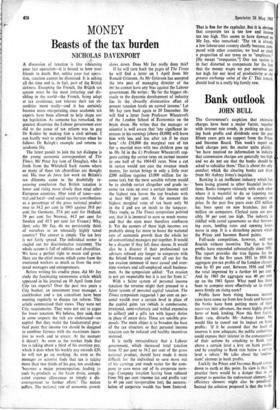Bank outlook
JOHN BULL
The Government's suspicion that excessive charges have been a major factor, together with interest rate trends, in pushing up clear- ing bank profits and dividends over the past fifteen years gets no support from the Prices and Incomes Board. This week's report on bank charges puts the matter quite plainly: 'we have received no information to indicate that commission charges are generally too high and we do not see that the banks should be asked to subsidise them.' That is about the only comfort which the clearing banks can draw from Mr Aubrey Jones's inquiries.
Banking is an inefficient industry which has been losing ground to other financial institu- tions. Banks compete viciously with each other where it is wasteful to do so (opening too many branches) and refuse to compete on price. In the past five years over £33 million has been spent on new branches, just £8 million on computers. Clerical costs are pos- sibly 30 per cent too high. The industry is riddled with cartel agreements so that borrow- ing costs, lending rates and opening hours move in step. It is a disturbing picture which the Prices and Incomes Board paints.
Full-scale competition, however, will not flourish without incentive. The fact is that profits have expanded substantially since 1951. The report provides the true figures for the first time. In the five years 1951 to 1956 the aggregate pre-tax profits of the London clearers rose by 83 per cent. Between 1956 and 1961 the total improved by a further 64 per cent. And by 1965 the aggregate was 40 per cent up on the 1961 figure. What need has there been to compete more effectively or to stamp more firmly on rising costs? Profits have been rising because interest rates have come up from low levels and because the banks have been putting more of their resou-ces into advances, the most highly priced form of bank lending. Now this first factor, Bank rate, disturbs Mr Aubrey Jones. He would like to cancel out its impact on bank profits: 'if it be assumed that the level of reserves is now adequate, the public authorities could express their interest in the consequences of their actions by attaching to Bank rate above a certain level a levy on bank profile. and by coupling to Bank rate below a certain level a rebate.' He talks about the 'endow- ment' element in bank profits. Luckily the Prices and Incomes Board come; down to earth at this point. Its view is that 'in practice there would be a danger that in an attempt to penalise the endowment element, the, efficiency element might also be penalised.' Instead the solution proposed is that the trade
tional links between Bank rate and clearing bank borrowing and lending rates should be wrenched apart, that on both sides of the equation banks should compete. If this drives up costs and reduces revenue, then the banks should set about realising the savings which would result from conducting hire-purchase business and other financial operations off the back of the branch system rather than putting such activities into separate companies.
What we have here is a radical solution to a fast-disappearing problem. The expansion of bank profits has come to an end. In the first place, it is unlikely that the proportion of assets tied up in advances can increase much further, if at all. Secondly, the rise in interest rates which started in 1951 has now levelled off. Thirdly, the banks are already moving into new fields for which enormous resources are needed. I do not doubt that Barclays Bank, for instance, is taking hefty losses on its credit- card business this year and probably next. The same goes for the Westminster and Lloyds ex- cursions into unit trusts. Fourthly, there is com- petition coming from the Post Office Giro.
Bank shareholders need not alter their dis- positions on account of Mr Aubrey Jones. But the report does the investing public a service in the sense that it presents information about clearing banks which has been unavailable hitherto. I have already referred to the pre- tax profits statistics. Apart from showing a strong upward trend they also show how volatile earnings can be on a year-to-year basis. In 1952 bank profits fell by 6 per cent, in 1955 there was a decline of 22 per cent, and in 1962 the aggregate fell back by 16f per cent. This is the kind of bad news the market must expect from time to time if full dis- closure is finally forced upon the financial institutions.



































 Previous page
Previous page